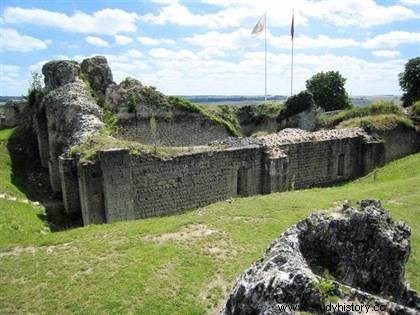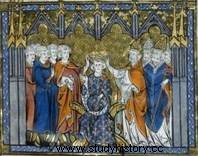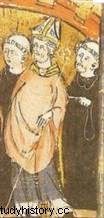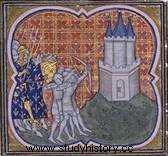 The Principality of Duke Richard II marks a turning point in the history of Normandy :the descendants of the Vikings finally freed themselves from their roots and turned definitively towards the Frankish world, both in the structures of government and in their religious beliefs, but also with regard to trade.
The Principality of Duke Richard II marks a turning point in the history of Normandy :the descendants of the Vikings finally freed themselves from their roots and turned definitively towards the Frankish world, both in the structures of government and in their religious beliefs, but also with regard to trade.
Genealogy of Richard II
Richard II is the fourth Duke of Normandy. Son of Gunnor, the concubine of Duke Richard I, he was born around 960 and succeeded his father in 996. He died on August 23, 1026. He first married Judith, daughter of Conan of Brittany, who gave him several children:
- Richard, future Duke Richard III of Normandy;
- Robert, future Duke Robert the Magnificent;
- Guillaume de Fécamp, abbot of the abbey of Fécamp;
- Adélaïde, wife of Count Renaud I of Burgundy;
- Aliénior, wife of Count Baudouin IV of Flanders;
- Mathilde, wife of Count Eudes II of Blois.
Judith dies in 1017; she is buried in the Abbey of Bernay, a monastery which she founded thanks to the dower received from her husband. The Duke took Papia as his concubine, from a wealthy Talou family. She gives him as children:
- Mauger of Rouen, Archbishop of Rouen:
- Guillaume, Count of Arques.
The beginnings of the principality under the tutelage of Raoul d'Ivry
 Richard was about fifteen years old when his father died and it was his uncle Raoul d'Ivry as well as his mother Gunnor who take over the government of the duchy. Raoul d'Ivry was a powerful lord, probably one of the first to officially bear the title of count within the duchy. Son of Asperleng de Pîtres and Sprota, he is largely possessed in Hiemois. At his request, Dudon de Saint-Quentin resumed the work commissioned by Duke Richard I and therefore continued writing his work "De moribus et actis primorum Normanniae ducum" Around 950, Count Raoul had the castle of Ivry built (Ivry -la-Bataille) which stands opposite the possessions of the Count of Eudes de Blois. The story goes that it was his wife Éremburge who would have supervised the construction carried out by the architect Lanfred (who built the keep of Pithiviers) and that she would then have had him assassinated so that he took to the grave its technical secrets. Count Raoul would later kill his wife to keep control of the fortress.
Richard was about fifteen years old when his father died and it was his uncle Raoul d'Ivry as well as his mother Gunnor who take over the government of the duchy. Raoul d'Ivry was a powerful lord, probably one of the first to officially bear the title of count within the duchy. Son of Asperleng de Pîtres and Sprota, he is largely possessed in Hiemois. At his request, Dudon de Saint-Quentin resumed the work commissioned by Duke Richard I and therefore continued writing his work "De moribus et actis primorum Normanniae ducum" Around 950, Count Raoul had the castle of Ivry built (Ivry -la-Bataille) which stands opposite the possessions of the Count of Eudes de Blois. The story goes that it was his wife Éremburge who would have supervised the construction carried out by the architect Lanfred (who built the keep of Pithiviers) and that she would then have had him assassinated so that he took to the grave its technical secrets. Count Raoul would later kill his wife to keep control of the fortress.
The beginning of Richard's principate, between 996 and 997, was marked by a revolt that stirred up all of Normandy. Guillaume de Jumièges speaks of a rebellion of the peasants, exasperated by the demands of the lords concerning the management of waterways, fisheries, mills and forests, but it is also possible that, as with previous successions, the minority of the new duke incites some of the Norman lords to challenge his authority. Count Raoul represses the revolt with cruelty:the deputies of the peasants in revolt are seized; their eyes are gouged out, their feet and hands cut off.
Raoul carrying out his orders without delay, immediately seized all the deputies and a few other men, and having their hands and feet cut off, he sent them back to theirs, thus put out of commission, so that the sight of what had happened to some might turn others away from such enterprises, and making them more prudent would safeguard them from greater evils. Having seen these things, the peasants left their assemblies, and returned to their plows. (Guillaume de Jumièges, History of the Normans, book III, chapter I, remacle.org translation)
Shortly afterwards, William Count of Hiémois, natural son of Richard I, rebels against his half-brother and contests his title of duke. Count Raoul captures the felon and locks him up under guard in a prison in the castle of Rouen. The rest of the adventure is perhaps legend. Thanks to the complicity of Lesceline, the daughter of his jailer Tourquetil d'Harcourt, he manages, after five years of captivity, to escape - with the help of a very long rope attached to a very high window. . (Guillaume de Jumièges, History of the Normans, book III, chapter I, translation remacle.org) - and remains alone, wandering in the woods. One day hunting in the forest of Vernon, his brother Richard II meets him by chance and discovers what a miserable man he has become.
Immediately, rolling on the ground at her feet, he painfully begged her forgiveness for his faults. The duke, touched with compassion, and on the advice of count Raoul, raised him from the ground, and when he had learned from his story the details of his escape, he not only forgives him of his faults, but also, and as soon as he that moment he loved him with much benevolence, and like a very dear brother. (Guillaume de Jumièges, History of the Normans, book III, chapter I, remacle.org translation) - Guillaume receives the county of Eu and marries Lesceline. This gives him three sons, Robert, heir to the county who will participate for 60 ships in the expedition of Duke William the Conqueror to England, William and Hugues, bishop of Lisieux.
A duke with a reputation equal to that of the king
 Duke Richard II is a very great lord, at the head of a duchy whose economic life and radiation grow rapidly. He is the equal of the greatest lords of the kingdom of the Franks, the friend of King Robert I the Pious, whose piety he shares in particular. The duke combines all the powers:he collects taxes, mints money, watches over the church, appoints bishops and abbots, raises men to ensure the defense of his lands without the king of France, his suzerain, intervening.
Duke Richard II is a very great lord, at the head of a duchy whose economic life and radiation grow rapidly. He is the equal of the greatest lords of the kingdom of the Franks, the friend of King Robert I the Pious, whose piety he shares in particular. The duke combines all the powers:he collects taxes, mints money, watches over the church, appoints bishops and abbots, raises men to ensure the defense of his lands without the king of France, his suzerain, intervening.
A growing duchy
Richard II reorganizes the counties of his duchy and places at the head of these members of his family, from legitimate unions or not, in particular for those who place themselves in the border areas of its lands. The counts are delegated all the powers of the duke over the territory entrusted to them, but they can be revoked at any time. This ruling minority of Scandinavian origin rubs shoulders with large Frankish families who remained in Normandy.
The Duke most often resides in his castle of Fécamp, but he has other residences, including those of Rouen and Bayeux, and he moves willingly from one to the other. It probably has an administration, made up of at least a chancellor, and clerks to write the acts and diplomas, with perhaps in addition a chaplain and a bottler.
 He maintains relations with the Greats of the Kingdom and in particular Robert the Pious whom he receives twice, a first once in Fécamp in 1006 and a second time in Rouen in 1024. It is related to England, the Scandinavian Kingdoms. For the first time, relations are established with the Pope. Economic life is developing. Rouen is the capital of the duchy and a major trading port, hub of slave trade and spoils from the raids of Viking armies with which the duchy remains in contact. In this port where tanneries and cloth industries are developing, Scandinavians, French, English and Flemings rub shoulders. Taxes levied on goods - the tonlieux - enriched the duke.
He maintains relations with the Greats of the Kingdom and in particular Robert the Pious whom he receives twice, a first once in Fécamp in 1006 and a second time in Rouen in 1024. It is related to England, the Scandinavian Kingdoms. For the first time, relations are established with the Pope. Economic life is developing. Rouen is the capital of the duchy and a major trading port, hub of slave trade and spoils from the raids of Viking armies with which the duchy remains in contact. In this port where tanneries and cloth industries are developing, Scandinavians, French, English and Flemings rub shoulders. Taxes levied on goods - the tonlieux - enriched the duke.
Living conditions are relatively good and Norman peasants do not experience serfdom. They are not overwhelmed by chores. They cultivate cereals, wheat and barley as well as vines. The breeding of pigs and cattle as well as the exploitation of sea salt complete these activities.
 Richard also oversees the development of religious and monastic life within his duchy, thus continuing the work of his father. He completes the restoration of the bishoprics and chooses bishops from among the members of his family. Robert, Archbishop of Rouen, is the Duke's brother; his successor will be Mauger, natural son of Richard II. Hugues and Jean, sons of Raoul d'Ivry, are respectively bishop of Bayeux and bishop of Avranches. Note that these bishops are great lords who lead a life consistent with their social status. They hunt and make war. At the same time, Richard II wishes to support the monasticism of the monks of Cluny who wish to restore all its value to the rule of Saint Benedict, by promoting prayer and intellectual work.
Richard also oversees the development of religious and monastic life within his duchy, thus continuing the work of his father. He completes the restoration of the bishoprics and chooses bishops from among the members of his family. Robert, Archbishop of Rouen, is the Duke's brother; his successor will be Mauger, natural son of Richard II. Hugues and Jean, sons of Raoul d'Ivry, are respectively bishop of Bayeux and bishop of Avranches. Note that these bishops are great lords who lead a life consistent with their social status. They hunt and make war. At the same time, Richard II wishes to support the monasticism of the monks of Cluny who wish to restore all its value to the rule of Saint Benedict, by promoting prayer and intellectual work.
In 1001, he asked Guillaume de Volpiano, prayer of the abbey of Cluny, to come and settle in the abbey of Fécamp in order to reform it. After some hesitation due to the troubled past of the Duke's ancestors, Guillaume de Volpiano accepted. He settled with 12 companions in the abbey which quickly experienced considerable influence. Subsequently, the duke entrusted him with the abbeys of Jumièges, Saint-Ouen and Mont-Saint-Michel. In addition, charters return to the Norman abbeys the property of which they have been despoiled and new monasteries are created. The duke finances the constructions; he sponsors the journey of one hundred pilgrims to the Holy Land.
Relations with King Robert the Pious
Robert the Pious succeeded his father Hugues Capet in 996. He found in the person of Duke Richard II a faithful ally. As such, Richard intervenes militarily on several occasions alongside the king. According to Orderic Vital or Guillaume de Jumièges, in 999, Count Eudes de Blois, jealous of the prestige that Count Bouchard II of Vendôme (†1007) still called Bouchard the Venerable had with the king, seized the stronghold of Melun which once belonged to his ancestor Thibault le Tricheur. The king orders him to return it, but the count replies that as long as he is alive, he will not return it to anyone. Then begins the siege of the city. The Count of Anjou Foulques Nerra (970, †1040) and the king's army camped on the left bank while the Normans of Richard II invested the right bank.
 Similarly, Richard II committed himself to the king in his ten-year struggle to to bring the Duchy of Burgundy back to the crown, following the death of Duke Henry (848, †1002), son of Hugh the Great. In 1006, he also committed his troops to his suzerain and the Emperor Henry II against the Duke of Flanders, who seized the city of Valenciennes, in the land of the Holy Roman Empire.
Similarly, Richard II committed himself to the king in his ten-year struggle to to bring the Duchy of Burgundy back to the crown, following the death of Duke Henry (848, †1002), son of Hugh the Great. In 1006, he also committed his troops to his suzerain and the Emperor Henry II against the Duke of Flanders, who seized the city of Valenciennes, in the land of the Holy Roman Empire.
But the king also ensures that his ally's interests are not violated. Count Eudes II of Blois married Mathilde, sister of Richard II, with half the castellany of Dreux as dower. The young woman dies quickly and Duke Richard claims the restitution of the entire dower, which the Count of Blois refuses. Richard then built the fortress of Tilières to face that of Dreux. Then, after Count Eudes tried to seize this fortress, the duke asked for help from kings Olaf of Norway (995, †1030) and Lacman of Sweden. They land in Brittany, besiege and take the castle of Dol which they set on fire. Then, they make their way to Rouen where the duke welcomes them eagerly. King Robert the Pious, worried by these Viking troop movements, provoked an assembly of lords at Coudres in 1013 and summoned the two enemies there. Each exposes his grievances; the king imposes an agreement:the count of Blois keeps Dreux and Richard the right to keep the castle of Tilières. He also undertakes to send the two Scandinavian leaders back to their kingdom. But before returning to Norway, King Olaf converted to the Christian faith and was baptized in Rouen by Archbishop Robert the Dane, brother of Duke Richard II of Normandy.
Relations with the English king Ethelred
 In 991, Duke Richard I and King Ethelred II of England (966, †1016) under the aegis of Pope John XV concludes an agreement stipulating that they must not bring aid to their respective enemies. The Norman duke undertakes in particular not to help the Viking troops who attack the English kingdom.
In 991, Duke Richard I and King Ethelred II of England (966, †1016) under the aegis of Pope John XV concludes an agreement stipulating that they must not bring aid to their respective enemies. The Norman duke undertakes in particular not to help the Viking troops who attack the English kingdom.
At the start of Richard II's principality, King Ethelred considers the agreement broken and accuses Duke Richard of assisting the troops of the Danish king Sven at Forked Beard ( 985, †1014) who continue to assail his kingdom. In 1000 and 1001, he organized a retaliatory raid on the Cotentin coast. The troops of the English king are decimated. However, Richard, supported by Raoul d'Ivry, negotiates. A new agreement is sealed; Richard promises his neutrality; Ethelred marries Emma, the Duke's sister.
On November 13, 1002, St. Brice's Day, King Ethelred orders the massacre of all the Scandinavians in his kingdom. King Sven Forked-Beard's sister is among the victims. The latter immediately launched retaliatory raids in 1003, 1006 and 1009. In 1013, Sven seized the English kingdom; Ethelred flees and finds refuge in Normandy with his wife Emma and his two sons, Edouard and Alfred.
Duke Richard Welcomes Emma and Her Two Sons, The Story of Saint King Edward Translated from the Latin, c. 1250, Cambridge University Library.
In 1014, Sven dies. Immediately, Ethelred sets out again for England with Emma in order to fight against Cnut who succeeded to her father. But Ethelred is defeated and dies. Cnut marries Emma in order to legitimize his position. Edward and Alfred stayed with the Duke and were brought up at his court, thus forging very strong ties with the Norman princes.
The end
Richard II died in August 1026 in Fécamp. His eldest son Richard is designated as heir to the duchy while Robert, his younger brother, is made count of Hiémois.
Bibliography
- Jean Renaud, the Vikings and Normandy, Ouest France editions
- Annie Fettu, The first Dukes of Normandy, Orep Editions
- François Neveux, The adventure of the Normans, Perrin editions
- Jean Renaud, The Vikings in France, Editions Ouest France
- Pierre Bauduin, The first Normandy (10th-11th century) Caen, Caen University Press, 2nd edition, 2006.
Sources
- Guillaume de Jumièges, Gesta Normannorum Ducum, History of the Normans, translation remacle.org
- Dudon de Saint-Quentin, De moribus et actis primorum Normanniae ducum, Ed. Jules Lair, Caen, F. Le Blanc-Hardel, 1865
- Richer, History in four books, published by the Imperial Academy of Reims, translation A.M. Poinsignon, source Gallica.
